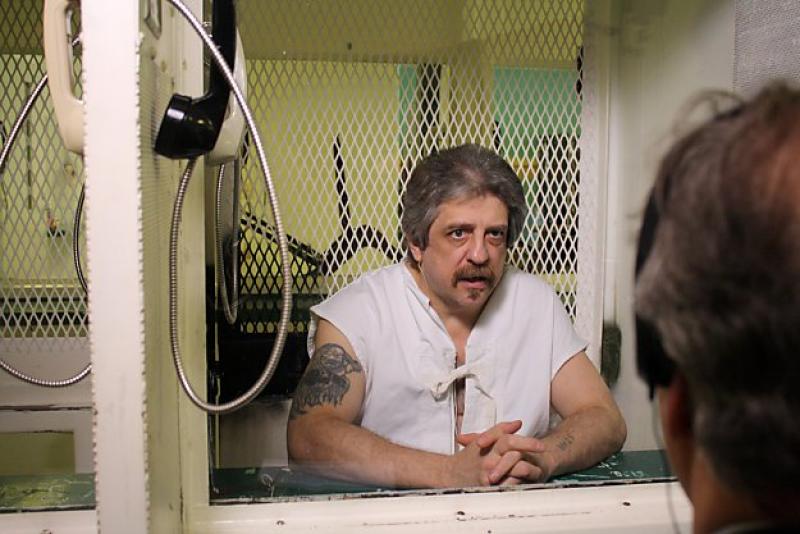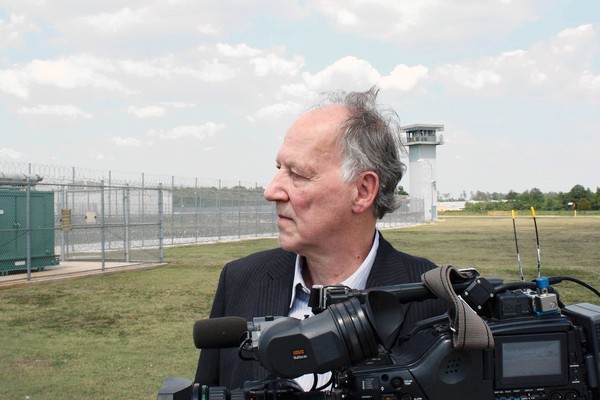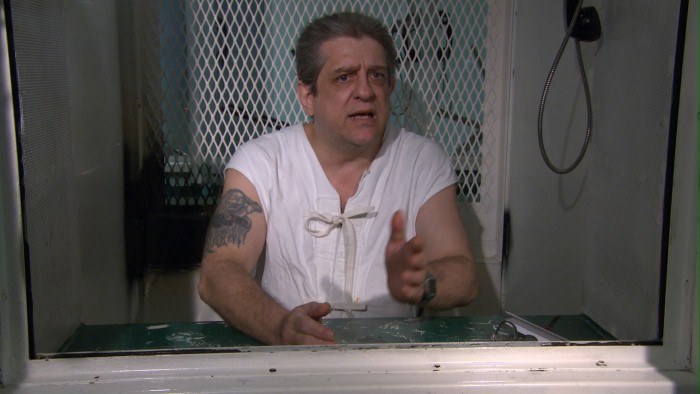Death Row, Channel 4 | reviews, news & interviews
Death Row, Channel 4
Death Row, Channel 4
The disquieting first entry in Werner Herzog's series on America's condemned

“A place of human bondage, a place of human suffering,” was how Hank Skinner described the Texas prison where he’s spent the 17 years. On death row, he's convicted of triple murder. The subject of the disquieting first entry in Werner Herzog’s series on condemned prisoners, Skinner was sanguine in the face of death but pursuing every means to prolong its arrival.
Although unseen, Herzog was heard. The programme began with his voiceover stating that “the death penalty exists in 34 states of the United States of America. Currently, only 16 states actually perform executions. Executions are carried out by lethal injection. As a German, coming from a different historical background and being a guest in the United States, I respectfully disagree with the practice of capital punishment."
 Death Row fit snugly into the Herzog (pictured right) canon. The director's fascination with America is long standing – that is, the America between the eastern and western seaboards. From 1977’s Stroszek through to and beyond his 2009 film The Bad Lieutenant: Port of Call New Orleans, he has appreciated the great dream has an antithesis. Made for the otherwise senstionalist US crime channel Investigation Discovery, Death Row evolved as a complementary piece to his 2011 film Into the Abyss, released in the UK on March 30. Into the Abyss dwelt on one case. Likewise, each of this series's four episodes is dedicated to a single case. The film and Death Row are symbiotic.
Death Row fit snugly into the Herzog (pictured right) canon. The director's fascination with America is long standing – that is, the America between the eastern and western seaboards. From 1977’s Stroszek through to and beyond his 2009 film The Bad Lieutenant: Port of Call New Orleans, he has appreciated the great dream has an antithesis. Made for the otherwise senstionalist US crime channel Investigation Discovery, Death Row evolved as a complementary piece to his 2011 film Into the Abyss, released in the UK on March 30. Into the Abyss dwelt on one case. Likewise, each of this series's four episodes is dedicated to a single case. The film and Death Row are symbiotic.
Skinner was prime material for Herzog: a subject beyond the margins of society, in extreme circumstances with an ambivalent façade that sporadically slipped. The prisoner talked from behind glass – filmed over two sessions limited by prison rules – and the director visited the small Texan town of Pampa, where the crimes took place. Apart from the introduction, Herzog offered no views on the death penalty.
The Pampa we saw was a desperate, edge-of-the-earth place. The camera swept over vacated lots, empty garages, abandoned warehouse units. Herzog captured this environment in 2005’s The Wild Blue Yonder. The local newsman who covered the murders Skinner was convicted of said he heard about them by being told “we have a triple”. Skinner’s then-girlfriend had been bludgeoned to death. Her two mentally impaired sons had been stabbed. The tour of the town takes place in the shadow of looming snowstorm, further darkening the atmosphere.
 In his expositions, Skinner was articulate. He’s had practice. The case is well known in America. He'd blogged about it and had his stance worked out. But the coverage of the case wasn’t a concern for Herzog, who wanted to get the measure of a man facing death. In fact, Skinner (pictured) had already been minutes from execution and was given the last rites. The phone call staying the lethal injection came within half an hour of the execution. This meant Skinner was able to detail his copious final meal.
In his expositions, Skinner was articulate. He’s had practice. The case is well known in America. He'd blogged about it and had his stance worked out. But the coverage of the case wasn’t a concern for Herzog, who wanted to get the measure of a man facing death. In fact, Skinner (pictured) had already been minutes from execution and was given the last rites. The phone call staying the lethal injection came within half an hour of the execution. This meant Skinner was able to detail his copious final meal.
Herzog calmly noted that Skinner saw himself as part of a lineage. His ancestors, said the prisoner, include persecuted medieval Knights Templar. Quoting from The Epic of Gilgamesh, he drew parallels with his situation. “Connections”, as Herzog put it, "are everywhere". Even when you’ve been in jail for 17 years.
Tracing the journey from Skinner's prison to the execution facility, Herzog captured the passing landscape and found it allegorical. Seeing it anew, he imbued it with meaning. Similarly, Death Row might have seemed dispassionate, but Herzog's characteristic reserve imbued it with meaning. Shouting wasn't necessary to get the point across.
Watch Werner Herzog explaining his views on the death penalty
Explore topics
Share this article
The future of Arts Journalism
You can stop theartsdesk.com closing!
We urgently need financing to survive. Our fundraising drive has thus far raised £49,000 but we need to reach £100,000 or we will be forced to close. Please contribute here: https://gofund.me/c3f6033d
And if you can forward this information to anyone who might assist, we’d be grateful.

Subscribe to theartsdesk.com
Thank you for continuing to read our work on theartsdesk.com. For unlimited access to every article in its entirety, including our archive of more than 15,000 pieces, we're asking for £5 per month or £40 per year. We feel it's a very good deal, and hope you do too.
To take a subscription now simply click here.
And if you're looking for that extra gift for a friend or family member, why not treat them to a theartsdesk.com gift subscription?
more TV
 theartsdesk Q&A: director Stefano Sollima on the relevance of true crime story 'The Monster of Florence'
The director of hit TV series 'Gomorrah' examines another dark dimension of Italian culture
theartsdesk Q&A: director Stefano Sollima on the relevance of true crime story 'The Monster of Florence'
The director of hit TV series 'Gomorrah' examines another dark dimension of Italian culture
 The Monster of Florence, Netflix review - dramatisation of notorious Italian serial killer mystery
Director Stefano Sollima's four-parter makes gruelling viewing
The Monster of Florence, Netflix review - dramatisation of notorious Italian serial killer mystery
Director Stefano Sollima's four-parter makes gruelling viewing
 The Diplomat, Season 3, Netflix review - Ambassador Kate Wyler becomes America's Second Lady
Soapy transatlantic political drama keeps the Special Relationship alive
The Diplomat, Season 3, Netflix review - Ambassador Kate Wyler becomes America's Second Lady
Soapy transatlantic political drama keeps the Special Relationship alive
 The Perfect Neighbor, Netflix review - Florida found-footage documentary is a harrowing watch
Sundance winner chronicles a death that should have been prevented
The Perfect Neighbor, Netflix review - Florida found-footage documentary is a harrowing watch
Sundance winner chronicles a death that should have been prevented
 Murder Before Evensong, Acorn TV review - death comes to the picturesque village of Champton
The Rev Richard Coles's sleuthing cleric hits the screen
Murder Before Evensong, Acorn TV review - death comes to the picturesque village of Champton
The Rev Richard Coles's sleuthing cleric hits the screen
 Black Rabbit, Netflix review - grime and punishment in New York City
Jude Law and Jason Bateman tread the thin line between love and hate
Black Rabbit, Netflix review - grime and punishment in New York City
Jude Law and Jason Bateman tread the thin line between love and hate
 The Hack, ITV review - plodding anatomy of twin UK scandals
Jack Thorne's skill can't disguise the bagginess of his double-headed material
The Hack, ITV review - plodding anatomy of twin UK scandals
Jack Thorne's skill can't disguise the bagginess of his double-headed material
 Slow Horses, Series 5, Apple TV+ review - terror, trauma and impeccable comic timing
Jackson Lamb's band of MI5 misfits continues to fascinate and amuse
Slow Horses, Series 5, Apple TV+ review - terror, trauma and impeccable comic timing
Jackson Lamb's band of MI5 misfits continues to fascinate and amuse
 Coldwater, ITV1 review - horror and black comedy in the Highlands
Superb cast lights up David Ireland's cunning thriller
Coldwater, ITV1 review - horror and black comedy in the Highlands
Superb cast lights up David Ireland's cunning thriller
 Blu-ray: The Sweeney - Series One
Influential and entertaining 1970s police drama, handsomely restored
Blu-ray: The Sweeney - Series One
Influential and entertaining 1970s police drama, handsomely restored
 I Fought the Law, ITVX review - how an 800-year-old law was challenged and changed
Sheridan Smith's raw performance dominates ITV's new docudrama about injustice
I Fought the Law, ITVX review - how an 800-year-old law was challenged and changed
Sheridan Smith's raw performance dominates ITV's new docudrama about injustice
 The Paper, Sky Max review - a spinoff of the US Office worth waiting 20 years for
Perfectly judged recycling of the original's key elements, with a star turn at its heart
The Paper, Sky Max review - a spinoff of the US Office worth waiting 20 years for
Perfectly judged recycling of the original's key elements, with a star turn at its heart

Add comment